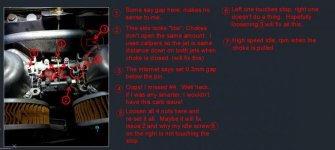TEM666666
Member
Offline
Need some help!
Cold engine, no problem. As the car got hot I got loud popping noise from exhaust.
Now I did monkey around with everything a couple months ago because it (she?) didn't start after winter storage. Ends up to be both float bowl valves jammed up. Free'd it up and got it running again. Since I turned the jet mixture nuts (probably shouldn't have?), So I went back to scratch.. I set the jets 1/8th (0.125") below flush with calipers and played with it from there (lifting piston with screw driver to check mixture). I drove 40mins home no problems (on fresh 87 octane gas). I didn't drive the car much since I brought it home. 2 weekends ago, I put in 93 octane gas (ethanol free! yay!).. Drove home, no issues.
Yesterday, I went for a drive. When the car got warm, that's when I got the loud popping noise on acceleration. Rules say that's running too rich (too much fuel). Today I checked the spark plugs, pitch black! I turned the jet nuts up (anti clockwise looking down from above) to lean it out a bit, push up the piston lifting pins.. Got to where if I pushed up, it did nothing, then after a few seconds the rpm's dropped and engine shakes like it's about to stall out. Also adjusted idle screws to keep rpm around 1100 since idle rpm changed when I changed mixture... I drove it between adjustments. Am I still running way too rich? Still popping randomly on acceleration. When it pops the car is jerky too.
What's the fix? I have driven last year fine on high octane gas (only ethanol free gas around). So I'm guessing it's not fuel? Or is it? Or still running too rich? I feel I may have pushed the piston lifting pin up too much so I did it wrong?
Cold engine, no problem. As the car got hot I got loud popping noise from exhaust.
Now I did monkey around with everything a couple months ago because it (she?) didn't start after winter storage. Ends up to be both float bowl valves jammed up. Free'd it up and got it running again. Since I turned the jet mixture nuts (probably shouldn't have?), So I went back to scratch.. I set the jets 1/8th (0.125") below flush with calipers and played with it from there (lifting piston with screw driver to check mixture). I drove 40mins home no problems (on fresh 87 octane gas). I didn't drive the car much since I brought it home. 2 weekends ago, I put in 93 octane gas (ethanol free! yay!).. Drove home, no issues.
Yesterday, I went for a drive. When the car got warm, that's when I got the loud popping noise on acceleration. Rules say that's running too rich (too much fuel). Today I checked the spark plugs, pitch black! I turned the jet nuts up (anti clockwise looking down from above) to lean it out a bit, push up the piston lifting pins.. Got to where if I pushed up, it did nothing, then after a few seconds the rpm's dropped and engine shakes like it's about to stall out. Also adjusted idle screws to keep rpm around 1100 since idle rpm changed when I changed mixture... I drove it between adjustments. Am I still running way too rich? Still popping randomly on acceleration. When it pops the car is jerky too.
What's the fix? I have driven last year fine on high octane gas (only ethanol free gas around). So I'm guessing it's not fuel? Or is it? Or still running too rich? I feel I may have pushed the piston lifting pin up too much so I did it wrong?

 Hi Guest!
Hi Guest!

 smilie in place of the real @
smilie in place of the real @
 Pretty Please - add it to our Events forum(s) and add to the calendar! >>
Pretty Please - add it to our Events forum(s) and add to the calendar! >> 


